
Salami Tactics and a Coup
Salami tactics refers to a divide and conquer approach, which aims to split up the opposition. The expression evokes the idea of slicing up one’s opposition in the same way as one might slice up a salami. — politicaldictionary.com
The entire face of the world changed when Hungarian Prime Minister Ferenc Nagy agreed to resign from his premiership on 31 May 1947.
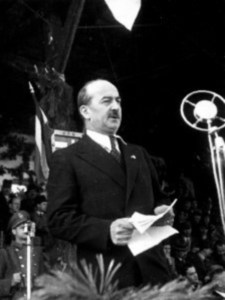
Although violence was involved, it was not a violent overthrow. There was still a need for a (manufactured) reason to oust both the most powerful party in post-war Hungary and its committed-to-democracy leader. And that reason came, after eighteen months of salami tactics by the Hungarian Communist Party, in the form of minor party discussions about the future of Hungary without the Soviet Union.
It was enough to be blown into a conspiracy of the highest proportions, to cause a kidnapping and Soviet prison sentence, and be one of triggers of the American policy that underscored the Cold War known as The Truman Doctrine.
Ferenc Nagy’s (no relation to the ill-fated Hungarian leader Imre Nagy) roots were amongst the peasant class. He was self-taught, but before the age of thirty managed to be one of the co-founders of the Independent Smallholders Party, which was made up of Hungarian peasants and the urban middle class agitating for land reform and democratization. The ISP were heavily involved in anti-Nazi and anti-fascist activities, both overt and covert, during World War II, and Nagy even spent time imprisoned by the Nazis before being quietly released by the Hungarian government and going into hiding.
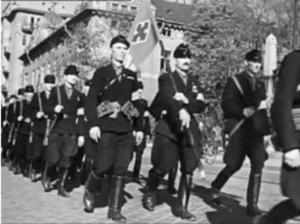
When the war ended, the ISP won a majority of votes in the first post-war election, but as a former Axis participant the nation was still being overseen by the Allied Control Commission (ACC). The ACC was chaired by a Soviet representative, and it was this representative that forced the ISP to accept a coalition government with the Communist Party and the Social Democrats. Nagy was named the Speaker of the Parliament. This translated into the role of Prime Minister in February 1946 when Hungary became a republic.
Nagy saw that the Hungarian Communist Party was attempting to gain control of the government through other means, as they had not pulled in a majority of votes during the election. But he also thought that he could bide his time and wait them out until the Soviet occupation forces left. Led by Matyos Rakosi, who received support and orders from the Soviet Occupation, the Hungarian Communist Party (HCP) began to try to block ISP power and influence in small-but-increasing ways. These so-called salami tactics were possibly named by Rakosi himself when he said, “[We destroyed them by] cutting them off like pieces of salami.”
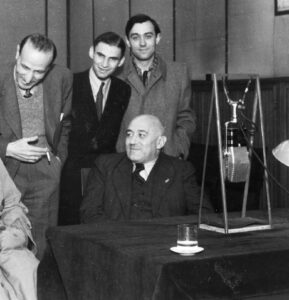
Initially this took the form of forcing the expulsion of twenty “reactionaries” within the ISP in order to diminish the party’s majority. These twenty expelled members then came together to form the anti-communist Hungarian Freedom Party. The Communist Party then moved to create a “Left-Wing Bloc” composed of the Communists, Social Democrats, and the National Peasant Party with the sole goal of blocking all ISP-sponsored government business.
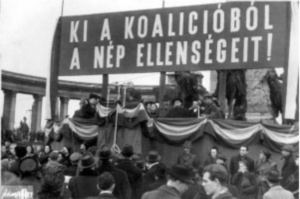
A major opportunity against the ISP was created for the HCP on 17 June 1946, when Soviet soldiers in Budapest were attacked by an alleged member of the Catholic-sponsored Scouts Association. The Soviet head of the ACC immediately put the blame for the attack on elements within the ISP in an official letter to the Hungarian government, “…every kind of underground fascist organization that deals with propaganda and acts of terrorism finds a legal for for itself in the Independent Smallholders party.” He accused them of anti-Soviet and pro-fascist propaganda, and claimed, “[they are] occupying a high position in the state apparatus while openly or covertly supporting fascist elements through their work.”
The Communist Laszlo Rajk, the Minister of the Interior, took the opportunity to act independently of the government by using the attack to unilaterally ban most civil, religious, and youth organizations. It was a major step toward incapacitating the non-communists in Hungary by denying them opportunities to meet and plan.
Ferenc Nagy immediately saw the direction the government was moving and began to speak out publicly attempting to expose the salami tactics happening behind the scenes.
Among the parties of the Left-Wing Bloc, and more immediately, the leaders and masses of the workers’ parties, the idea has become dominant that there are counter-revolutionary endeavors at work in Hungary seeking to overthrow democracy, and that these efforts receive support, partly or wholly, from one of the coalition parties, the largest one, the Independent Smallholders Party. –Ferenc Nagy
In December 1946 the HCP discovered something that they knew could be a game-changer. Handled correctly, they would no longer have to dismantle the ISP slice by slice, but in one swoop.
Members of several of the smaller parties elected to the Hungarian Parliament had been discussing, in their private meetings, the direction they wished to take the Hungarian government when the Soviet Union and the ACC were no longer in charge of Hungary’s post-war administration.
On the face of it, this seems to be hardly revelatory; planning for future events is the smartest way to be prepared. But Rakosi and the HCP were able to spin it as a vast conspiracy that needed to be rooted out.
“This conspiracy has enormous significance for us because it confirms in detail and in full all we have been saying about reactionaries trying to work through the Smallholders Party…This conspiracy has great significance because it will strongly affect the whole course of the strategy we have planned for the year 1947. This is a heavy stone, which is still flying through the air, and there is no knowing where it will strike. We must do our best to maximize its effect,” Rakosi related to a December 1946 meeting of the Hungarian Communist Party.
Closer examination showed that some of the members of the smaller groups had been a part of a pre-war ethnically based organization called Hungarian Community. Hungarian Community was both anti-semitic and anti-German; and as these same members would be nebulously tied to the ISP.
Controlled by the HCP, Hungarian State Security attempted to arrest Kalman Salata, Prime Minister Nagy’s secretery, but Salata was able to flee across the border.
The next person targeted was not so lucky. On 25 February 1947, the Minister of Agriculture and General Secretary of the ISP, Bela Kovacs, was kidnapped by Soviet forces, taken to the Soviet Union, and charged with organizing underground anti-Soviet groups. He was completely broken by Soviet interrogators and sentenced to twenty years in prison.
Rakosi was ready to completely decimate the ISP and take control, but Kovac’s forced rendition was one of the triggers of an American act that caused even the Soviet Union to pause and consider their actions: The Truman Doctrine.
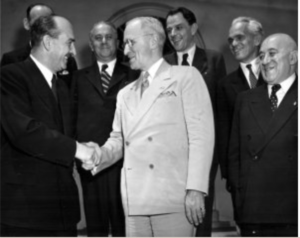
I believe it must be the policy of the US to support free peoples who are resisting attempted subjugation by armed minorities or by outside pressures. I believe that we must assist free peoples to work out their own destinies in their own way. I believe our help should be primarily through economic and financial aid which is essential to economic stability and orderly political process. –Harry Truman, 12 March 1947
Immediate plans for a full Hungary take-over were halted while the Soviet Union reassessed plans, but Rakosi was determined. First, he managed to cobble together a weak connection between Nagy and the “conspiracy” that had been the impetus for the arrest of 50 ISP members of parliament and the kidnapping of Bela Kovacs. Next, Rakosi demanded that the broken Kovacs be brought back for a Hungarian show trial to publicly denounce Nagy.
The Soviets, still reassessing, refused.
But Nagy himself gave the HCP the excuse they needed: on 14 May 1947 he departed for Switzerland; officially on vacation, but most likely to attempt to gain support from western nations.
On 28 May the Soviets released their evidence of Nagy’s involvement in conspiracies. They also seized Nagy’s four-year-old son Laszlo as a hostage.
Nagy had no choice: on 31 May he agreed to resign from his position as Prime Minister, although he did not release his resignation until his son was safely in Switzerland with him. The ISP almost immediately fell into disarray.
The communist take-over of Hungary was complete.
Ferenc Nagy was given asylum in the United States, where he wrote a book and gave lectures, living in Herndon, Virginia. He did not return to Hungary during the 1956 Revolution, claiming that he did not want to justify claims that the uprising came from outside Hungary.
He died on 12 June 1979 in Herndon, Virginia. Just over ten years later, communism would fall in Hungary.
To read more about Hungary, please click here.
- May 31, 2021
- History
